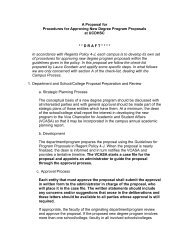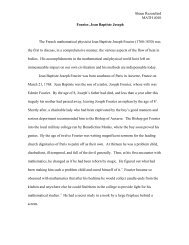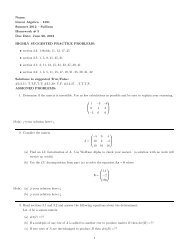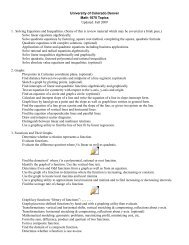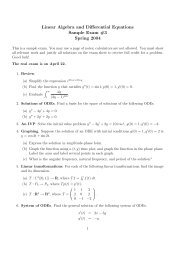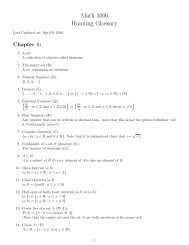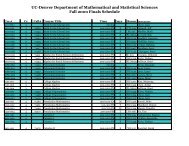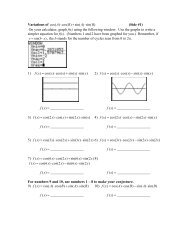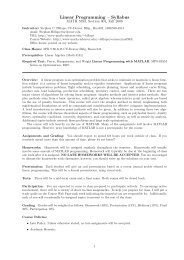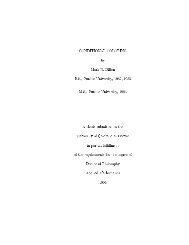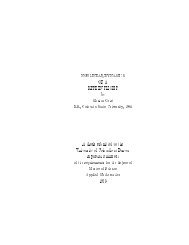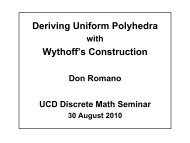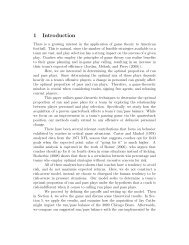Advanced Euclidean Geometry
Advanced Euclidean Geometry
Advanced Euclidean Geometry
Create successful ePaper yourself
Turn your PDF publications into a flip-book with our unique Google optimized e-Paper software.
<strong>Advanced</strong> <strong>Euclidean</strong><br />
<strong>Geometry</strong>
What is the center of a triangle?<br />
But what if the triangle is not equilateral?<br />
?
Circumcenter<br />
Equally far from the vertices?<br />
P<br />
A B<br />
P<br />
A B<br />
Points are on the<br />
perpendicular<br />
bisector of a line<br />
segment iff they<br />
are equally far<br />
from the endpoints.<br />
P<br />
I II<br />
A Q B<br />
P<br />
I II<br />
A B<br />
Δ I ≅ Δ II (SAS)<br />
PA = PB<br />
Δ I ≅ Δ II (Hyp-Leg)<br />
AQ = QB
Circumcenter<br />
Thm 4.1 : The perpendicular bisectors of the sides of a triangle are<br />
concurrent at a point called the circumcenter (O).<br />
B<br />
A<br />
O<br />
C<br />
Draw two perpendicular bisectors of<br />
the sides. Label the point where they<br />
meet O (why must they meet?)<br />
Now, OA = OB, and OB = OC (why?)<br />
so OA = OC and O is on the<br />
perpendicular bisector of side AC. <br />
The circle with center O, radius OA<br />
passes through all the vertices and is<br />
called the circumscribed circle of the<br />
triangle.
Examples:<br />
Circumcenter (O)
B<br />
A<br />
C<br />
Orthocenter<br />
The triangle formed by joining the midpoints<br />
of the sides of ΔABC is called the medial<br />
triangle of ΔABC.<br />
The sides of the medial triangle are parallel<br />
to the original sides of the triangle.<br />
A line drawn from a vertex to the opposite<br />
side of a triangle and perpendicular to it is an<br />
altitude.<br />
Note that in the medial triangle the perp. bisectors are altitudes.<br />
Thm 4.2: The altitudes of a triangle are concurrent at a point called<br />
the orthocenter (H).
Orthocenter (H)<br />
Thm 4.2: The altitudes of a triangle are concurrent at a<br />
point called the orthocenter (H).<br />
The circumcenter<br />
of the blue triangle<br />
is the orthocenter<br />
of the original<br />
triangle.<br />
H
Examples:<br />
Orthocenter (H)
Equally far from the sides?<br />
A<br />
B<br />
C<br />
Incenter<br />
Points which are<br />
equally far from the<br />
sides of an angle are<br />
on the angle bisector.<br />
A<br />
I<br />
II<br />
B<br />
C<br />
P<br />
A<br />
I<br />
B<br />
II<br />
P<br />
C<br />
ΔI ≅ ΔII (AAS)<br />
PB = PC<br />
ΔI ≅ ΔII (leg-hypotenuse)<br />
∠BAP ≅ ∠CAP
Incenter (I)<br />
Thm 4.3 : The internal bisectors of the angles of a triangle meet at<br />
a point called the incenter (I).<br />
A<br />
C'<br />
B'<br />
I<br />
B<br />
A'<br />
Draw two internal angle bisectors, let I<br />
be the point of their intersection (why<br />
does I exist?)<br />
Drop perpendiculars from I to the<br />
three sides of the triangle.<br />
IA' = IC' and IB' = IC' so IA' = IB' and<br />
C I is on the angle bisector at C.<br />
The incenter is the center of the inscribed circle, the circle tangent<br />
to each of the sides of the triangle.
Examples:<br />
Incenter (I)
How about the center of gravity?<br />
Centroid (G)<br />
A median of a triangle is a line segment joining a vertex to<br />
the midpoint of the opposite side of the triangle.<br />
Examples:<br />
Thm 4.4 : The medians of a triangle meet at a point called the<br />
centroid (G).<br />
We can give an ugly proof now<br />
or<br />
a pretty proof later.
Internal Bisectors<br />
Thm 4.5: The internal bisector of an angle of a triangle divides the<br />
opposite side into two segments proportional to the sides of the<br />
triangle adjacent to the angle.<br />
C<br />
E<br />
D<br />
A<br />
Draw parallel to AD through C, extend AB<br />
to E.<br />
∠ BAD = ∠ AEC (corr. angles of ∥ lines)<br />
∠ ECA = ∠ CAD (alt. int. angles of ∥'s)<br />
so AE = AC (isoceles triangle)<br />
B<br />
ΔABD ~ ΔEBC (AA)<br />
BA AE<br />
BA<br />
⇒ AC<br />
BA<br />
= BDDC<br />
BD<br />
= DC<br />
BD
Excenter<br />
Thm 4.6: The external bisectors of two angles of a triangle meet<br />
the internal bisector of the third angle at a point called the<br />
excenter.<br />
A<br />
B<br />
C<br />
E<br />
There are 3 excenters of a triangle.<br />
An excenter is the center of an<br />
excircle, which is a circle exterior<br />
to the triangle that is tangent to the<br />
three sides of the triangle.<br />
At a vertex, the internal angle<br />
bisector is perpendicular to the<br />
external angle bisector.
A Circle Theorem<br />
Thm 4.9: The product of the lengths of the segments from an<br />
exterior point to the points of intersection of a secant with a circle<br />
is equal to the square of the length of a tangent to the circle from<br />
that point.<br />
B<br />
A<br />
C<br />
P<br />
∠PAC ≅ ∠ABC since both<br />
are measured by ½ arc AC.<br />
ΔPAC ~ ΔABP (AA)<br />
PC PA<br />
=<br />
PA PB<br />
PA 2 = PC PB .
a<br />
b<br />
h<br />
c<br />
Area Formulas<br />
A = ½ bh<br />
Heron's formula for the area of a triangle.<br />
A= s s−a s−b s−c, where s= abc<br />
2<br />
the semiperimeter<br />
Brahmagupta's formula for the area of a cyclic quadrilateral.<br />
A= s−a s−b s−c s−d
Directed Segments<br />
The next few theorems involve the lengths of line segment and we<br />
want to permit directed lengths (positive and negative).<br />
By convention we assign to each line an independent direction.<br />
Each length measured in the same direction as the assigned one is<br />
positive and those in the opposite direction are negative.<br />
A B A B<br />
AB positive, BA negative AB negative, BA positive<br />
With this convention, internal ratios are always positive and external<br />
ratios are always negative.<br />
A C B<br />
A B C<br />
AC<br />
CB<br />
AC<br />
CB<br />
0<br />
0
Menelaus' Theorem<br />
Thm 4.10 : Menelaus's Theorem. If three points, one on each side<br />
of a triangle are collinear, then the product of the ratios of the<br />
division of the sides by the points is -1. (Alexandria, ~ 100 AD)<br />
A<br />
D E<br />
B C<br />
AD<br />
DB<br />
BF<br />
FC<br />
CE<br />
= −1<br />
EA<br />
F
I<br />
B'<br />
II<br />
A<br />
D E<br />
A'<br />
III<br />
B C<br />
Menelaus' Theorem<br />
C'<br />
IV V<br />
F<br />
BF<br />
CF<br />
Thus AD<br />
DB<br />
ΔI ~ ΔΙΙ, ΔΙΙΙ∼ ΔΙV, and<br />
ΔV ~ ΔFB'B<br />
AD<br />
DB<br />
CE<br />
EA<br />
BB '<br />
=<br />
CC '<br />
BF CE AA'<br />
=<br />
FC EA BB'<br />
AA'<br />
=<br />
BB'<br />
CC '<br />
=<br />
AA'<br />
BF<br />
so<br />
FC<br />
BB '<br />
= −<br />
CC '<br />
CC ' −BB '<br />
AA' CC '<br />
= −1 .
Converse of Menelaus<br />
Thm 4.11 : Converse of Menelaus's Theorem.<br />
If the product of the ratios of division of the sides by three points,<br />
one on each side of a triangle, extended if necessary, is -1, then the<br />
three points are collinear.<br />
Pf:<br />
F<br />
C<br />
D<br />
D'<br />
A<br />
E<br />
B<br />
We assume that AD<br />
DC<br />
CF<br />
FB<br />
BE<br />
EA<br />
= −1<br />
Join E and F by a line which intersects AC at D'.<br />
We will show that D' = D, proving the theorem.<br />
By Menelaus we have:<br />
AD' CF BE<br />
= −1, so<br />
D' C FB EA<br />
AD' CF BE AD CF BE<br />
=<br />
D' C FB EA DC FB EA<br />
AD'<br />
=<br />
D ' C<br />
AD<br />
DC<br />
⇒<br />
AD'<br />
1 =<br />
D' C<br />
AD<br />
DC 1<br />
AD' D ' C<br />
D' C<br />
= ADDC<br />
DC<br />
⇒ AC<br />
=<br />
D' C<br />
AC<br />
DC<br />
Thus, D ' C = DC so D '=D .
Ceva's Theorem<br />
Thm 4.13 : Ceva's Theorem. Three lines joining vertices to points<br />
on the opposite sides of a triangle are concurrent if and only if the<br />
product of the ratios of the division of the sides is 1. (Italy, 1678)<br />
B<br />
D<br />
A<br />
K<br />
F<br />
E<br />
C<br />
AF, BE and CD are<br />
concurrent at K iff<br />
AD<br />
DB<br />
BF<br />
FC<br />
CE<br />
EA<br />
= 1 .
B<br />
D<br />
A<br />
K<br />
F<br />
Ceva's Theorem<br />
Now multiply, cancel and be careful with<br />
sign changes to get:<br />
E<br />
AD<br />
DB<br />
C<br />
BF<br />
FC<br />
Assume the lines meet at K.<br />
Apply Menelaus to ΔAFC:<br />
AK<br />
KF<br />
CE<br />
EA<br />
FB<br />
BC<br />
= 1 .<br />
CE<br />
EA<br />
= −1<br />
Apply Menelaus to ΔAFB:<br />
AD<br />
DB<br />
BC<br />
CF<br />
FK<br />
KA<br />
= −1
Ceva's Theorem<br />
Note that the text does not provide a proof of the converse of<br />
Ceva's theorem (although it is given as an iff statement).<br />
This converse is proved in a manner very similar to that<br />
used for the proof of the converse of Menelaus' theorem.<br />
I think this is a very good exercise to do, so consider it a<br />
homework assignment.<br />
This converse is often used to give very elegant proofs<br />
that certain lines in a triangle are concurrent. We will<br />
now give two examples of this.
Centroid Again<br />
Thm 4.4 : The medians of a triangle meet at a point called the<br />
centroid (G).<br />
Pf: A<br />
C<br />
B'<br />
A'<br />
C'<br />
B<br />
Since A', B' and C' are midpoints,<br />
we have AB' = B'C, CA' = A'B and<br />
BC' = C'A. Thus,<br />
AB'<br />
B' C<br />
CA'<br />
A' B<br />
BC '<br />
C ' A<br />
= 111 = 1<br />
So, by the converse of Ceva's<br />
theorem, AA', BB' and CC' (the<br />
medians) are concurrent. ❑
Gergonne Point<br />
Thm 4.14: The lines from the points of tangency of the incircle to<br />
the vertices of a triangle are concurrent (Gergonne point).<br />
C<br />
B'<br />
A<br />
A'<br />
C'<br />
B<br />
Pf: Since the sides of the triangle are<br />
tangents to the incircle, AB' = AC',<br />
BC' = BA', and CA' = CB'. So,<br />
AB'<br />
B' C<br />
CA'<br />
A' B<br />
BC '<br />
C ' A<br />
= 1<br />
So, by the converse of Ceva's<br />
theorem, the lines are concurrent.
Simson Line<br />
Thm 4.15: The three perpendiculars from a point on the<br />
circumcircle to the sides of a triangle meet those sides in collinear<br />
points. The line is called the Simson line. (No proof)<br />
B<br />
A<br />
C
Miquel Point<br />
Thm 4.19 : If three points are chosen, one on each side of a<br />
triangle then the three circles determined by a vertex and the two<br />
points on the adjacent sides meet at a point called the Miquel<br />
point.<br />
Example:
Pf: A<br />
C<br />
Miquel Point<br />
E G<br />
J<br />
H<br />
F<br />
D<br />
I<br />
B<br />
In circle J,<br />
∠EGD + ∠C = π.<br />
In circle I,<br />
∠FGD + ∠B = π.<br />
Since ∠EGF + ∠FGD + ∠EGD + ∠A + ∠B + ∠C = 2π + π, by<br />
subtracting we get ∠EGF + ∠A = π and so A,E,G and F are<br />
concyclic (on the same circle).
Feuerbach's Circle<br />
Thm 4.16 : The midpoints of the sides of a triangle, the feet of the<br />
altitudes and the midpoints of the segments joining the orthocenter<br />
and the vertices all lie on a circle called the nine-point circle.<br />
Example:
The 9-Point Circle Worksheet<br />
We will start by recalling some high school geometry facts.<br />
1. The line joining the midpoints of two sides of a triangle is parallel to the<br />
third side and measures 1/2 the length of the third side of the triangle.<br />
a) Why is the ratio of side AD to side AB 1:2?<br />
b) In the diagram, ΔDAE is similar to ΔBAC<br />
because ....<br />
Since similar triangles have congruent angles,<br />
we have that ∠ADE ≅ ∠ABC.<br />
c) Line DE is parallel to BC because ....<br />
d) Since the ratio of corresponding sides of similar triangles is constant,<br />
what is the ratio of side DE to side BC?
The 9-Point Circle Worksheet<br />
2. Four points, forming the vertices of a quadrilateral, lie on a<br />
circle if and only if the sum of the opposite angles in the<br />
quadrilateral is 180 o .<br />
e) An angle inscribed in a circle has measure equal to 1/2 the<br />
measure of the arc it subtends. In the diagram above, what<br />
arc does the ∠DAB subtend? What arc does the opposite<br />
∠BCD subtend?<br />
f) Since the total number of degrees of the arc of the full circle<br />
is 360 o , what is the sum of the measures of ∠DAB and<br />
∠BCD?
9-Point Circle Worksheet<br />
Three points, not on a line, determine a unique circle. Suppose we<br />
have four points, no three on a line. We can pick any three of these<br />
four and construct the circle that contains them. The fourth point<br />
will either lie inside, on or outside of this circle. Let's say that the<br />
three points determining the circle are A, B and C. Call the fourth<br />
point D. We have already seen that if D lies on the<br />
circle, then m(∠ADC) + m(∠ABC) = 180 o .<br />
g) What can you say about the size of ∠ADC if D lies inside the<br />
circle? What is then true about m(∠ADC) + m(∠ABC)?<br />
h) What can you say about the size of ∠ADC if D lies outside<br />
the circle? What is then true about m(∠ADC) + m(∠ABC)?
9-Point Circle Worksheet<br />
A trapezoid is a quadrilateral with two parallel sides. An isosceles trapezoid<br />
is one whose non-parallel sides are congruent.<br />
3. The vertices of an isosceles trapezoid all lie on a circle.<br />
Consider the isosceles trapezoid ABCD below, and draw the line through A<br />
which is parallel to BC. This line meets CD in a point that we label E.<br />
i) What kind of quadrilateral is ABCE?<br />
j) What does this say about the sides AE and BC?<br />
k) ΔDAE is what kind of triangle?
9-Points Circle Worksheet<br />
Because AE is parallel to BC, ∠BCE ≅ ∠AED (corresponding angles of<br />
parallel lines). And so, by k) this means that ∠BCD ≅ ∠ADE.<br />
l) Show that ∠DAB ≅ ∠ABC.<br />
This means that the sums of the opposite angles of the isosceles trapezoid<br />
are equal.<br />
m) Show that the sums of the opposite angles of an isosceles trapezoid<br />
are 180 o .
9-Points Circle Worksheet<br />
4. In a right triangle, the line joining the right angle to the midpoint of the<br />
hypotenuse has length equal to 1/2 the hypotenuse.<br />
Draw the circumscribed circle O about the right triangle ABC with right<br />
angle A.<br />
n) What is the measure of the arc subtended by angle A?<br />
o) What kind of line is BC with respect to this circle?<br />
p) Where is the center of the circle?<br />
q) Prove the theorem.
9-Points Circle Worksheet<br />
We are now ready to discuss the Feuerbach circle.<br />
For an arbitrary triangle, the 3 midpoints of the sides, the 3 feet of the<br />
altitudes and the 3 points which are the midpoints of the segments joining<br />
the orthocenter to the vertices of the triangle all lie on a circle, called the<br />
nine-points circle.<br />
There is a circle passing through the 3 midpoints of the sides of the triangle,<br />
A', B' and C'. We shall show that the other 6 points are on this circle also.<br />
Let D be the foot of the altitude from A. Consider the quadrilateral A'DB'C'.<br />
We claim that this is an isoceles trapezoid.<br />
r) Why is A'D parallel to B'C' ?<br />
s) Why is DB' equal in length to 1/2 AC?<br />
t) Why is A'C' equal in length to 1/2 AC?
9-Points Circle Worksheet<br />
Since A'DB'C' is an isosceles trapezoid, D must<br />
be on the same circle as A', B' and C'. The other<br />
altitude feet (E and F) are dealt with similarly.<br />
u) Determine the isosceles trapezoid that<br />
contains E and the one that contains F.<br />
Now consider J, the midpoint of the segment<br />
joining the orthocenter H to the vertex A. Draw<br />
the circle that has A'J as its diameter.<br />
v) Why is A'B' parallel to the side AB?<br />
w) Why is JB' parallel to the altitude CF?<br />
x) Show that A'B' is perpendicular to JB'.
9-Points Circle Worksheet<br />
Angle JB'A' is thus a right angle and so, B' must<br />
be on the circle with diameter A'J.<br />
y) In an analogous manner, prove that C' is on<br />
the circle with diameter A'J.<br />
We therefore have J, A', B' and C' all on the same<br />
circle, which is the circle we started with.<br />
By repeating this argument starting with the<br />
circles having diameters KB' and LC', we can<br />
show that K and L are also on this circle.
9-point Circle<br />
Thm 4.17: The centroid of a triangle trisects the segment joining<br />
the circumcenter and the orthocenter. [Euler line]<br />
C<br />
A<br />
H<br />
A'<br />
O<br />
M<br />
B<br />
Draw circumcircle and<br />
extend radius CO to<br />
diameter COM.<br />
ΔCBM ~ ΔCA'O<br />
so OA' = ½MB<br />
Drop altitude from A, find<br />
orthocenter H.<br />
AMBH is a parallelogram,<br />
so AH = MB = 2OA'.
9-point Circle<br />
Thm 4.17: The centroid of a triangle trisects the segment joining<br />
the circumcenter and the orthocenter. [Euler line]<br />
A<br />
H<br />
G<br />
C A'<br />
O<br />
B<br />
Draw centroid G on median<br />
AA', 2/3 of the way from A.<br />
ΔHAG ~ ΔOA'G because<br />
AH = 2OA'<br />
AG = 2GA' and<br />
∠HAG ≅ ∠OA'G<br />
thus ∠HGA ≅ ∠OGA', and<br />
so H,G, and O are collinear<br />
with HG = 2 GO.
9-point Circle<br />
Thm 4.18: The center of the nine-point circle bisects the segment<br />
of the Euler line joining the orthocenter and the circumcenter of a<br />
triangle.<br />
B<br />
H<br />
A<br />
J<br />
A'<br />
O<br />
Recall from the last proof that AH =<br />
2OA'. Since J is the midpoint of AH,<br />
we have JH = OA'.<br />
Thus, JOA'H is a parallelogram.<br />
But JA' is a diameter of the 9-point<br />
circle, and also a diagonal of this<br />
parallelogram (HO being the other<br />
diagonal). Since the diagonals of a<br />
parallelogram bisect each other we<br />
have the conclusion.<br />
C
Morley's Theorem<br />
Thm 4.26: (Morley's Theorem) The adjacent trisectors of the<br />
angles of a triangle are concurrent by pairs at the vertices of an<br />
equilateral triangle.
Symmedian<br />
In a triangle, lines through a vertex that are symmetrically placed<br />
around the angle bisector of that vertex are called isogonal lines.<br />
One of these lines is called the isogonal conjugate of the other.<br />
Note that the angle bisector is also the angle bisector of the angle<br />
formed by a pair of isogonal lines.<br />
A symmedian is the isogonal conjugate of a median.<br />
Median<br />
Angle bisector<br />
Symmedian
LeMoine Point<br />
The symmedians of a triangle are concurrent at the<br />
LeMoine point (also called the symmedian point).<br />
This is a consequence of a more general result, namely:<br />
Theorem: The isogonal conjugates of a set of<br />
concurrent segments from the vertices to the opposite<br />
sides of a triangle are also concurrent.<br />
To prove this theorem we should recall the Law of<br />
Sines for a triangle.
c b<br />
B a C<br />
Law of Sines<br />
A<br />
a<br />
sin A<br />
= b<br />
sin B<br />
c b<br />
h<br />
B C<br />
c Sin (B) = h = b Sin (C)<br />
= c<br />
sinC
Theorem<br />
Theorem: The isogonal conjugates of a set of concurrent segments from<br />
the vertices to the opposite sides of a triangle are also concurrent.<br />
A<br />
F<br />
Pf: Assume G is point of<br />
E<br />
B”<br />
G” C”<br />
concurrency of AA”, BB” and<br />
CC”. Let AD, BE and CF be<br />
the isogonal conjugates of<br />
G<br />
these lines.<br />
The Law of Sines says that<br />
C D A” B<br />
in triangle AA”C,<br />
CA' '<br />
sin CAA' ' =<br />
CA<br />
sinCA' ' A<br />
or<br />
CAsin CAA' ' <br />
CA' ' =<br />
sinCA' ' A
Theorem<br />
Theorem: The isogonal conjugates of a set of concurrent segments from<br />
the vertices to the opposite sides of a triangle are also concurrent.<br />
Pf (cont): Similarly, in triangle AA”B, the law of sines leads to<br />
A' ' B=<br />
AB sin BAA' ' <br />
sin BA ' ' A<br />
Using the fact that supplementary angles CA”A and BA”A have the<br />
same sine, we can write.<br />
CA' ' CAsin CAA' ' <br />
=<br />
A' ' B AB sin BAA' ' .<br />
Repeating this for the other ratios of divisions leads to the<br />
trigonometric form of Ceva's theorem (and its converse):
Theorem<br />
Theorem: The isogonal conjugates of a set of concurrent segments from<br />
the vertices to the opposite sides of a triangle are also concurrent.<br />
Pf (cont):<br />
sin CAA' ' BCC ' ' ABB' ' <br />
⋅sin ⋅sin<br />
sin BAA' ' sin ACC ' ' sin CBB ' ' =1.<br />
Due to the isogonal conjugates we have the following equalities<br />
amongst the angles, BAA” = CAD, BCC” = ACF and CBB” = ABE.<br />
Also, CAA” = BAD, ACC” = BCF, and ABB” = CBE. So,<br />
sin BAD ACF CBE<br />
⋅sin ⋅sin<br />
sin CAD sin BCF sin ABE =1,<br />
showing that AD, BE and CF are concurrent.
Morley's Theorem<br />
The incenter I of triangle ABC lies on the angle bisector of angle A at a point<br />
where ∠BIC = 90 o + ½∠A.<br />
A<br />
B<br />
a + b<br />
b<br />
b<br />
a a<br />
I<br />
a + c<br />
a + b + a + c = a + b + c + a = ½(180 o ) + a = 90 o + a<br />
c<br />
c<br />
C
Morley's Theorem<br />
A direct proof of Morley's Theorem is difficult, so we will give an indirect<br />
proof which essentially works backwards.<br />
Start with an equilateral ΔPQR and<br />
construct on its sides isosceles triangles<br />
with base angles a, b and c, each less<br />
than 60 o and with a + b + c = 120 o C<br />
.<br />
Extend the sides of isosceles triangles<br />
below their bases until they meet again<br />
at points A, B and C.<br />
Since a + b + c + 60 = 180, we can<br />
calculate some other angles in the<br />
figure.<br />
R'<br />
b<br />
Q<br />
c<br />
a<br />
P<br />
a c<br />
b Q'<br />
P'<br />
b<br />
c c<br />
b a<br />
A<br />
a<br />
R<br />
B
Draw the sides of ΔABC and<br />
note the marked angles.<br />
Note the angles at Q and Q'.<br />
Claim: Q is the incenter of ΔCQ'A.<br />
QQ' is the perpendicular bisector of<br />
PR and so is the angle bisector at Q'.<br />
The angle at Q is = 90 o + ½∠ Q' and<br />
this means that Q is the incenter.<br />
Morley's Theorem<br />
C<br />
60-a<br />
Thus, QC and QA are angle bisectors in this<br />
triangle, so ∠QCA = 60-a and ∠QAC = 60-c.<br />
180-b<br />
R'<br />
b<br />
Q<br />
c<br />
a<br />
P<br />
a c<br />
b Q'<br />
P'<br />
b<br />
c c<br />
b a<br />
60-c<br />
A<br />
a<br />
R<br />
180-2b<br />
B
Similarly, P is the incenter<br />
of ΔBP'C and R is the<br />
incenter of ΔAR'B. Thus, ...<br />
The angles at A, B and C are<br />
trisected. We then have:<br />
a = 60 o – 1/3∠C<br />
b = 60 o – 1/3∠Β and<br />
c = 60 o – 1/3∠A<br />
Morley's Theorem<br />
C<br />
60-a<br />
60-a<br />
Now, start with an arbitrary ΔABC.<br />
Determine a, b and c from above and carry out<br />
the construction. The resulting triangle will be<br />
similar to the original and the statement of the<br />
theorem will be true for it. □<br />
60-a<br />
R'<br />
b<br />
Q<br />
c<br />
a<br />
60-c<br />
P<br />
a c<br />
b Q'<br />
P'<br />
b<br />
c c<br />
b a<br />
60-c<br />
A<br />
a<br />
R<br />
B<br />
60-c



